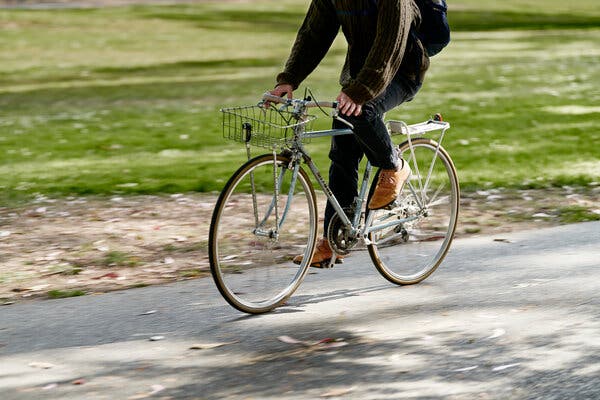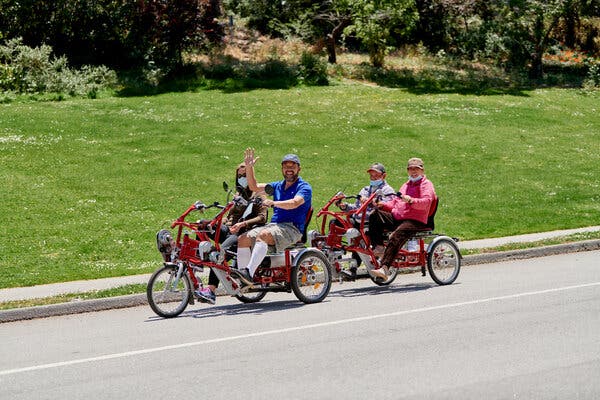Advertisement
Supported by
Not All Cyclists Wear Lycra
The biking world can be intimidating, even for those who grew up in it. But that’s no reason to let your pandemic wheels gather dust.

I’ve been a passionate, mediocre bicyclist most of my life. I’ve done 100-mile rides and placed nearly dead last, thanks to extended milkshake stops. I can replace an inner tube in 60 minutes flat, with only moderate cursing. I once broke my hip on a mountain bike after launching 10 feet through the air off a jump that I didn’t even know was there.
In other words, I dearly love biking — I’m just not great at it. I don’t own a biking jersey, let alone one covered in the logos of race sponsors. My gloves have holes in them, my socks don’t match and my water bottle is whatever I found in the garage, possibly my kid’s sippy cup.
But it’s the perfect speed between walking and driving — you can fly like a bird down a lonely highway or toodle past neighborhood gardens. An all-day hike becomes a couple hours on a mountain bike.
Today, biking is more popular than ever. The bike market grew 75 percent in April 2020 and hasn’t really stopped. For specialized bikes, wait times can be longer than a year. But it’s not clear that this pandemic bike-buying frenzy will turn into a long-term shift to biking. The last American bike boom, in the early ’70s, later petered out. How many bikes will end up gathering dust in the garage this time?
None, if people like Vivian Ortiz, Boston’s designated “bike mayor,” have anything to say about it. Like me, she’s used to getting strange looks from better-equipped, faster riders. “I’m a 58-year-old overweight woman who’s Puerto Rican,” she said. “So I’m riding a bike and they’re like, who the hell are you?”
Ms. Ortiz got into biking around 2012 at 50, a few years after moving to Boston and realizing public transportation wasn’t flexible enough. She hasn’t owned a car since and today works full-time to improve pedestrian and bike access for kids.
For her, biking isn’t about impressing the neighbors or even exercise; it’s a way to connect with others. It bothers Ms. Oritz that so few people of color have historically embraced the sport (though that is changing fast), and she spends her weekends gathering people — both friends and strangers she’s found — in her South Boston neighborhood to ride along the Neponset River.
That’s the thing about biking: If you think cyclists are all Lycra-wearing millionaires or invincible 15-year-olds flying off jumps, then you just haven’t met your biking people yet or found your perfect ride.
Whether you bought an impulse pandemic bike and haven’t used it, or you have an old cruiser hidden in your garage, now is a great time to get back in the saddle. Can’t ride? Feel overwhelmed by the biking world? Don’t worry, there’s a place there for you — right next to me and my kid’s sippy cup.
Start with a refresher.
If you never learned how to ride a bike, it’s not too late. Or, perhaps you just don’t remember, since the last bike you rode was bright pink with streamers on the handles. According to one moderately sized survey by YouGov, only 6 percent of Americans cannot ride a bike but more than half of us say we never do, which can be a problem for starting up again.
It turns out that riding a bike is nothing like riding a bike — you can forget how to do it. Also, biking on a trail or in traffic isn’t like BMXing around your neighborhood as a kid. And it can be dangerous to learn on the fly. Consider classes from places like REI, the League of American Bicyclists or your local bike shop.
Alison Dewey, the education director at the League of American Bicyclists and an occasional adult cycling instructor, said that classes can help you feel confident around cars or on a bumpy trail. Otherwise, find a bike path in your neighborhood or a fire road for a mountain bike. Or toss a rack on the car and go find a place you like.
Figure out what kind of bike you need.
These days there are road bikes and mountain bikes, but also velodromes, folding bikes, cruisers, hybrids, gravel bikes, BMX’s, touring bikes and e-bikes. Plus the odd recumbent, tandem or tricycle.
“We live in the best time that you could ever hope to be a cyclist,” said Tom Ritchey, the chairman of Ritchey Design, who invented some of the earliest mountain bike components and started the first company that sold them.
Mr. Ritchey said that before you buy a bike, know where you want to ride. Are you yearning to soar down the open road or bounce through cobbly streams? What trails and roads exist near your home? Where do your friends ride?
If you’re not sure or want to keep options open, hybrid or gravel bikes are good choices. Both are designed for streets and trails, but hybrids are more like mountain bikes that can also get you to work. Gravel bikes are road bikes that don’t mind a few pebbles.
But be realistic about where you will actually ride. It’s infuriating to slog down the street on a sluggish mountain bike. But the worst is riding a bike that doesn’t fit your body, Mr. Ritchey said. Mountain and road bike frames are measured differently, so it’s important to go to a bike shop and have someone fit you, even if you buy elsewhere.
Recommendations From Wirecutter for Bikes and Gear
The Best Bike Helmet for Commuters
The Best Bike Racks and Carriers
Maybe toss a motor in your bike for good measure.
The concept of a motor-assisted pedal bike goes back to the 1880s, but e-bikes only really became popular around the turn of this century. There are three types: Class 1 and 2 give you an extra nudge while pedaling, but max out at 20 miles per hour. Class 3 is faster and not always allowed on trails and bike paths.
I’d bet Mr. Morris, my junior high school fitness teacher, would call e-bikes something like a “dirty cheater’s shortcut.” But there is some evidence that having a motor at your fingertips actually increases fitness, particularly if you end up using the bike more or riding farther, though most of the research tracks users for only a few months.
While e-bikes are more expensive than most standard bikes, their proponents say they make sense for commuters and could even replace a car for some. They may also be useful for older riders who want to stay fit but struggle on local hills.
Mr. Ritchey agreed that e-bikes have benefits, but couldn’t hide his general distain for the devices, especially when ridden by someone who doesn’t seem to need one.
“When I see a 17-year-old pass me on an electric bike — yeah, it’s hard for me not to not to say something snide,” he said.

Decide where to ride.
According to the Rails-to-Trails Conservancy, America has 40,000 miles of multiuse trails — which is just 7,000 shy of the total for interstate highways.
Whether you have moved to a new area or just haven’t explored your town, bikes are an excellent way to find a new favorite place. Many cities have become more bike friendly, and it’s worth perusing their recommended routes, often away from traffic or on paved paths.
There are also plenty of biking apps. I’d say the best free program is REI’s MTB Project, which shows all the best trails in your area, color coded for difficulty, and lets you track your ride as you go. Rails-to-Trails has a pretty good national map for local bike trails. For city streets, Ms. Ortiz said Google Maps’ bike mode actually isn’t terrible.
“And what I love about it is how many times the bike trip is faster than the train,” she said.
If you are willing to pay, Strava and Komoot are good options for planning rides and building community.
Stay safe.
Ms. Dewey said the biggest concern she hears from new or returning riders is safety. There’s no question that biking can be scary — cars move fast and rocks aren’t fun to land on —but there are steps you can take to prevent getting injured. Buy a good helmet. Wear reflective clothing at night. Find people to bike with.
Ms. Ortiz said training can also help. One trick is to to look over your shoulder when a car comes up behind you to make a connection with the driver so they know you’re there. The same idea applies to pedestrians. Ms. Ortiz uses a bell to let people know she’s coming. If they don’t turn to look, they may have earbuds in, so slow down.
However, she and others said riders themselves should never wear earbuds. Much as I love jamming to vintage Rush or Guns N’ Roses while flying down the road, being a safe rider means using all your senses.
Mountain bikers face different dangers, like rocks, roots and (often) hubris. While YouTube is full of videos of maniacs bombing down hills, the discipline of mountain biking is actually about going slow. Good mountain bikers can maintain control even when practically stopped.
In the end, as with all adventures, the point is to have fun and see your world in a different way. Whether you’re a gutter bunny, flipper, Hasselhoff, gerbil or Fred, grab your tredder, fixie, yonka or hardtail — and hit the road.
Erik Vance is an editor for the Well desk.
Advertisement
